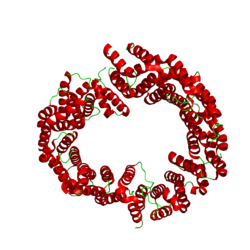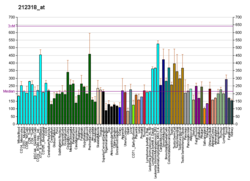Protein-coding gene in the species Homo sapiens
Transportin-3 is a protein that in humans is encoded by the TNPO3 gene .[5] [6] [7]
Function TNPO3 is a nuclear import receptor for serine/arginine-rich (SR) proteins, including Serine/arginine-rich splicing factor 1 , which are essential precursor-mRNA splicing factors .[5] [7]
Clinical significance The TNPO3-IRF5 locus is implicated in primary biliary cirrhosis and systemic sclerosis .[8]
References
^ a b c GRCh38: Ensembl release 89: ENSG00000064419 – Ensembl , May 2017^ a b c GRCm38: Ensembl release 89: ENSMUSG00000012535 – Ensembl , May 2017^ "Human PubMed Reference:" . National Center for Biotechnology Information, U.S. National Library of Medicine .^ "Mouse PubMed Reference:" . National Center for Biotechnology Information, U.S. National Library of Medicine .^ a b Kataoka N, Bachorik JL, Dreyfuss G (Jul 1999). "Transportin-SR, a nuclear import receptor for SR proteins" . J Cell Biol . 145 (6): 1145–52. doi :10.1083/jcb.145.6.1145 . PMC 2133142 PMID 10366588 . ^ Lai MC, Lin RI, Huang SY, Tsai CW, Tarn WY (Apr 2000). "A human importin-beta family protein, transportin-SR2, interacts with the phosphorylated RS domain of SR proteins" . J Biol Chem . 275 (11): 7950–7. doi :10.1074/jbc.275.11.7950 PMID 10713112 . ^ a b "Entrez Gene: TNPO3 transportin 3" .^ Radstake TR, Gorlova O, Rueda B, et al. (May 2010). "Genome-wide association study of systemic sclerosis identifies CD247 as a new susceptibility locus" . Nat. Genet . 42 (5): 426–9. doi :10.1038/ng.565 . PMC 2861917 PMID 20383147 .
Further reading
Maruyama K, Sugano S (1994). "Oligo-capping: a simple method to replace the cap structure of eukaryotic mRNAs with oligoribonucleotides". Gene . 138 (1–2): 171–4. doi :10.1016/0378-1119(94)90802-8 . PMID 8125298 . Suzuki Y, Yoshitomo-Nakagawa K, Maruyama K, et al. (1997). "Construction and characterization of a full length-enriched and a 5'-end-enriched cDNA library". Gene . 200 (1–2): 149–56. doi :10.1016/S0378-1119(97)00411-3 . PMID 9373149 . Lai MC, Lin RI, Tarn WY (2001). "Transportin-SR2 mediates nuclear import of phosphorylated SR proteins" . Proc. Natl. Acad. Sci. U.S.A . 98 (18): 10154–9. doi :10.1073/pnas.181354098 PMC 56931 PMID 11517331 . Allemand E, Dokudovskaya S, Bordonné R, Tazi J (2003). "A conserved Drosophila transportin-serine/arginine-rich (SR) protein permits nuclear import of Drosophila SR protein splicing factors and their antagonist repressor splicing factor 1" . Mol. Biol. Cell . 13 (7): 2436–47. doi :10.1091/mbc.E02-02-0102 . PMC 117325 PMID 12134081 . Strausberg RL, Feingold EA, Grouse LH, et al. (2003). "Generation and initial analysis of more than 15,000 full-length human and mouse cDNA sequences" . Proc. Natl. Acad. Sci. U.S.A . 99 (26): 16899–903. Bibcode :2002PNAS...9916899M . doi :10.1073/pnas.242603899 PMC 139241 PMID 12477932 . Scherer SW, Cheung J, MacDonald JR, et al. (2003). "Human chromosome 7: DNA sequence and biology" . Science . 300 (5620): 767–72. Bibcode :2003Sci...300..767S . doi :10.1126/science.1083423 . PMC 2882961 PMID 12690205 . Ota T, Suzuki Y, Nishikawa T, et al. (2004). "Complete sequencing and characterization of 21,243 full-length human cDNAs" . Nat. Genet . 36 (1): 40–5. doi :10.1038/ng1285 PMID 14702039 . Colland F, Jacq X, Trouplin V, et al. (2004). "Functional proteomics mapping of a human signaling pathway" . Genome Res . 14 (7): 1324–32. doi :10.1101/gr.2334104 . PMC 442148 PMID 15231748 . Gerhard DS, Wagner L, Feingold EA, et al. (2004). "The status, quality, and expansion of the NIH full-length cDNA project: the Mammalian Gene Collection (MGC)" . Genome Res . 14 (10B): 2121–7. doi :10.1101/gr.2596504 . PMC 528928 PMID 15489334 . Tsang HT, Connell JW, Brown SE, et al. (2006). "A systematic analysis of human CHMP protein interactions: additional MIT domain-containing proteins bind to multiple components of the human ESCRT III complex" . Genomics . 88 (3): 333–46. doi :10.1016/j.ygeno.2006.04.003 PMID 16730941 . Ewing RM, Chu P, Elisma F, et al. (2007). "Large-scale mapping of human protein-protein interactions by mass spectrometry" . Mol. Syst. Biol . 3 (1): 89. doi :10.1038/msb4100134 . PMC 1847948 PMID 17353931 .







